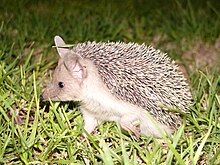Long-eared hedgehog
| Long-eared hedgehog | |
|---|---|
 |
|
| Scientific classification | |
| Kingdom: | Animalia |
| Phylum: | Chordata |
| Class: | Mammalia |
| Order: | Eulipotyphla |
| Family: | Erinaceidae |
| Genus: | Hemiechinus |
| Species: | H. auritus |
| Binomial name | |
|
Hemiechinus auritus (S. G. Gmelin, 1770) |
|
| Subspecies | |
|
H.a. auritus |
|
 |
|
| Geographic range of the long-eared hedgehog | |
H.a. auritus
H.a. albulus
H.a. aegyptius
H.a. libycus
H.a. megalotis
The long-eared hedgehog (Hemiechinus auritus) is a species of hedgehog native to Central Asian countries and some countries of the Middle East. The long-eared hedgehog lives in burrows that it either makes or finds and is distinguished by its long ears. It is considered one of the smallest middle eastern hedgehogs. This Hedgehog is insectivorous but may also feed on small vertebrates and plants. In captivity they may live as long as 7.6 years.
Since the long-eared hedgehog is naturally parasite prone and can carry diseases as bad as plague, it is highly recommended that, if kept as pet, it should be purchased from a respected dealer. Wild hedgehogs have been found to carry Rhipicephalus sanguineus, the brown dog tick, which can transmit Boutonneuse fever.
The length of the head and body of the long-eared hedgehog is approximately 120–270 mm, and the tail is 10–50 mm long. The skull is about 38–48 mm long. Unlike other species the pterygoids of the skull do not inflate and they do not relay information to the tympanic membrane. The ears of this hedgehog are 30–45 mm longer than the closest spine. They are used for heat radiation in the desert. Long-eared hedgehogs have great senses of hearing and smell that they use to hunt out food and detect predators. The long-eared hedgehog's spines are embedded in a unique muscle sheath that forms a bag-like structure which acts as protection for the hedgehog. They can withdraw into this pouch and erect their spines out to fend off predators if need be. The dorsal spines are white on the tip with darker banding below. They do not have dark and light areas on their faces. Also they do not have a gap of spines on the back of their necks that is common to other species of hedgehogs. The long-eared hedgehog has a light-colored underside along with whitish hairs on the tips of their ears. The tops and heels of their feet are covered with hair but the soles are bare.
...
Wikipedia

